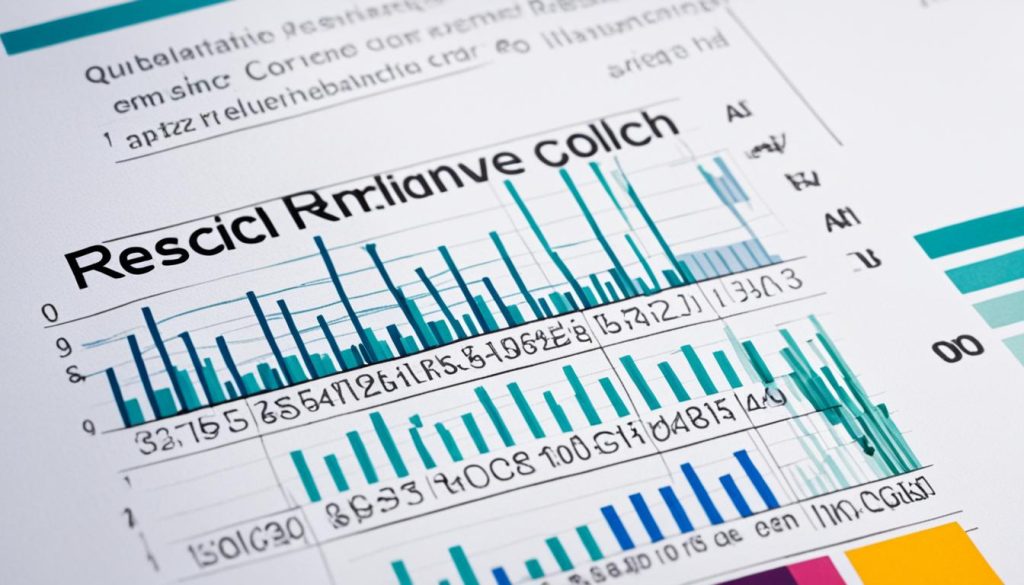Welcome to our comprehensive guide on quantitative research, its definition, importance, and methods. In this article, we will explore the fundamental concepts and applications of quantitative research, shedding light on its role in various fields.
Throughout this guide, we will delve into the various methods of quantitative research, the process of data analysis, the advantages and disadvantages, and the importance of proper data collection and hypothesis testing. By the end, you will have a comprehensive understanding of quantitative research and its applications in rigorous and valid research studies.
What is a Quantitative Research?
Quantitative research is a methodical investigation that uses measurable data to formulate facts and uncover patterns in research. It is a structured approach to collecting and analysing data, often using statistical techniques to draw conclusions and make predictions. This type of research is often used in social sciences, market research, and scientific studies.
In quantitative research, researchers use structured methods to collect data, such as surveys, questionnaires, and experiments. The data collected is typically numerical and can be analysed using statistical methods to identify trends, correlations, and relationships between variables. This type of research is valuable for providing quantifiable data that can be used to support or refute hypotheses, make predictions, and inform decision-making.
Quantitative Research Methods
Quantitative research methods are essential for gathering and analyzing numerical data to gain insights and make informed decisions. These methods can be applied to descriptive, correlational, or experimental research. Let’s explore each of these research approaches in more detail:
Descriptive Research
In descriptive research, the aim is to summarize and describe study variables. This method provides an overall snapshot of the observed phenomena without seeking to establish relationships or causality. For example, a survey conducted to determine the average age of smartphone users in a particular region.
Correlational Research
Correlational research focuses on examining relationships between variables. It aims to determine the extent to which changes in one variable are associated with changes in another variable. For instance, gathering data to analyze whether there is a correlation between smartphone usage and academic performance among students.
Experimental Research
In experimental research, researchers investigate cause-and-effect relationships between variables. This method involves manipulating one variable and observing its impact on another variable while controlling all other factors. An example would be conducting an experiment to test the effect of a new teaching method on student performance.
Quantitative research employs various methods to collect numerical data:
- Experiments: Controlled studies where variables are manipulated and measured to determine causal relationships.
- Surveys: Questionnaires administered to a sample population to gather data on attitudes, opinions, or behaviors.
- (Systematic) Observation: Systematically observing and recording data on predetermined variables in controlled or natural settings.
- Secondary Research: Analyzing existing data collected by others, such as data from government agencies or research institutions.
After collecting the data, researchers analyze it statistically to make predictions or test hypotheses. This involves employing various quantitative data analysis techniques, such as:
- Measures of central tendency (e.g., mean, median, mode) to summarize the data.
- Visual representations like graphs and scatter plots to visually analyze patterns and relationships.
- Hypothesis testing using statistical tests to determine the probability of certain outcomes occurring by chance.
Quantitative research methods provide several advantages:
- Standardized data collection allows for the replication and comparison of studies.
- Large sample sizes increase the reliability and generalizability of findings.
- Formalized hypothesis testing ensures rigor and careful consideration of research variables and predictions.

| Research Topic | Method Used |
|——————-|———————-|
|Effects of Exercise on Weight Loss|Experimental research|
|Customer Satisfaction in the Retail Industry|Survey research|
|Correlation Between Education Level and Income|Correlational research|
|Analysis of Economic Growth Rates by Country|Secondary research|
By utilizing quantitative research methods, researchers can gain valuable insights, make accurate predictions, and contribute to the advancement of knowledge in various fields.
Quantitative Data Analysis
Once data is collected in quantitative research, it undergoes a rigorous process of analysis to uncover insights and draw meaningful conclusions. Quantitative data analysis involves various techniques and methods that allow researchers to make informed decisions based on the numeric data collected.
One of the first steps in quantitative data analysis is transforming data from words to numbers. This process ensures that the information collected can be easily quantified and analyzed. Researchers use coding and categorization techniques to assign numerical values to different variables, enabling statistical analysis.
Descriptive statistics play a crucial role in summarizing the collected data. Measures of central tendency, such as mean, median, and mode, provide a snapshot of the average or most frequent values in the dataset. This information helps researchers understand the distribution and patterns within the data.
Visual representations, like graphs and scatter plots, are powerful tools in quantitative data analysis. They enable researchers to visualize relationships between variables and identify trends or outliers. Graphs and charts enhance the presentation of data, making it easier to communicate findings to a wider audience.
Inferential statistics allow researchers to make predictions or generalizations based on the collected data. Hypothesis testing is a commonly used technique that examines whether the observed data supports or contradicts a proposed hypothesis. By comparing the data to a known distribution, researchers can determine the likelihood of the observed relationship occurring by chance.
Here’s an example of a scatter plot depicting the relationship between demographic factors and purchase intent:
Benefits of Quantitative Research Methods
Quantitative research methods offer several advantages that make them valuable in various disciplines. Some of the key benefits include:
- Objectivity: Quantitative research relies on numerical data and statistical analysis, reducing the potential for bias and subjectivity in the findings.
- Generalizability: Through statistical analysis and large sample sizes, quantitative research allows for generalizing findings to larger populations, enhancing the external validity of the research.
- Replicability: The systematic nature of quantitative research ensures that studies can be replicated by other researchers, contributing to the cumulative knowledge in the field.
- Predictive Power: Quantitative research methods enable researchers to make predictions based on data analysis, supporting evidence-based decision-making.
- Rigorous Design: Quantitative research involves careful planning and design, ensuring the validity and reliability of the data collection process.
Overall, quantitative data analysis provides researchers with a systematic approach to extract valuable insights from numerical data. By employing a range of statistical techniques and methods, researchers can uncover patterns, relationships, and trends, leading to informed decision-making and the advancement of knowledge in various disciplines.
Advantages of Quantitative Research
Quantitative research offers several advantages in the pursuit of knowledge and understanding. By following a systematic approach, researchers can gather robust data and draw meaningful conclusions. Let’s explore some of the key advantages of quantitative research:
- Standardized Data Collection: Quantitative research follows a structured process, allowing for standardized data collection methods. This standardization enables researchers to repeat the study and compare results over time, ensuring consistency and reliability of the research findings.
- Large Sample Sizes: One of the strengths of quantitative research is the ability to work with large sample sizes. This gives the research greater statistical power, increasing the reliability and generalizability of the findings to the larger population.
- Hypothesis Testing: Quantitative research formalizes hypothesis testing, which involves carefully considering research variables, predictions, data collection methods, and testing techniques. This rigorous approach helps to establish causal relationships and determine the likelihood of patterns or relationships occurring by chance.
- Data Analysis Techniques: Quantitative research employs a wide range of data analysis techniques, such as measures of central tendency and hypothesis testing using statistical tests. These techniques enable researchers to draw accurate conclusions and make informed decisions based on the numeric data collected.
- Validity and Reliability: In quantitative research, data collection methods can be assessed for validity and reliability. Validity assesses whether the research measures what it intends to measure, while reliability evaluates the consistency of the data collection methods. These assessments enhance the credibility and trustworthiness of the research findings.

By leveraging the quantitative research process steps, applying appropriate quantitative research data analysis techniques, and ensuring validity and reliability, researchers can gain valuable insights and contribute to the advancement of knowledge in their respective fields.
Disadvantages of Quantitative Research
While quantitative research offers many advantages, it also has some limitations that researchers should be aware of. Understanding these drawbacks is crucial for conducting effective and valid research studies.
Superficial Representation of Complex Concepts
A potential limitation of quantitative research is its tendency to represent complex concepts with precise and restrictive operational definitions. This can result in oversimplification and the omission of important nuances in the data.
Narrow Focus on Predetermined Variables
In quantitative research, there is often a narrow focus on predetermined variables, which may lead to the overlooking of other relevant observations. This limited approach can hinder researchers from gaining a comprehensive understanding of the phenomena under investigation.
Structural Biases
Structural biases can impact the research process in quantitative studies. For example, missing data can introduce bias and affect the validity of the findings. Inappropriate sampling methods can also result in biased samples that do not accurately represent the target population.
Lack of Contextual Understanding
Quantitative research may sometimes lack the necessary contextual understanding due to its reliance on numerical data. This approach may result in the use of unnatural settings or the exclusion of historical and cultural factors that could influence data collection and research outcomes.

| Quantitative Research Design | Difference between Quantitative and Qualitative Research | Quantitative Research Techniques |
|---|---|---|
| Specifies the methods and procedures used in a quantitative research study. | Quantitative research involves the collection and analysis of numerical data, whereas qualitative research focuses on non-numerical data such as observations and interviews. | Quantitative research techniques include experiments, surveys, systematic observation, and secondary data analysis. |
| Guides researchers in selecting appropriate data collection methods and statistical analyses. | Quantitative research provides more structured and objective data, while qualitative research offers more in-depth and subjective insights. | These techniques allow for the collection, analysis, and interpretation of numerical data to derive meaningful conclusions. |
| Plays a crucial role in ensuring the validity and reliability of the research findings. | Quantitative research focuses on quantifying relationships and patterns, while qualitative research aims to understand the meaning and context of phenomena. | By employing various statistical tools and techniques, researchers can draw accurate and reliable conclusions from the collected data. |
Despite these limitations, quantitative research remains a valuable tool for generating data-driven insights and informing evidence-based decision-making. Researchers must carefully consider the strengths and weaknesses of this approach when designing their studies to ensure robust and valid results.
Data Collection in Quantitative Research
Data collection is a fundamental aspect of conducting quantitative research. It involves acquiring systematic and structured observations or measurements to support research objectives. By using a variety of tools and methods, researchers can gather quantitative data that can be analyzed statistically to draw meaningful conclusions and make informed decisions.
Quantitative research methods for data collection include:
- Surveys and Questionnaires: These structured tools allow researchers to collect data from a large number of participants efficiently. Surveys and questionnaires consist of carefully crafted questions that are administered to individuals or groups to gather specific information.
- Observation: Using systematic and controlled methods, researchers collect data by directly observing and recording behaviors, events, or processes. Observational data can be collected through structured or unstructured observation techniques.
- Secondary Research: Researchers analyze existing data collected by others to answer their research questions. Secondary research involves examining previously collected data, such as government reports, academic studies, or publicly available datasets.
These data collection methods provide researchers with numerical data that can be analyzed using statistical techniques. To ensure the representativeness of the sample and increase the reliability of the findings, researchers often employ probability sampling methods, such as simple random sampling, stratified sampling, or cluster sampling.
Data collection serves as the foundation of quantitative research, enabling researchers to analyze the collected data and draw conclusions. Through careful planning and execution of data collection methods, researchers can gather valuable insights to answer research questions and contribute to the field.

| Examples of Quantitative Research Studies | Quantitative Research Design |
|---|---|
| A study examining the correlation between sleep duration and academic performance among college students | Correlational Research Design |
| A survey investigating customer satisfaction levels with a new product | Survey Research Design |
| An experiment testing the effectiveness of a new medication in reducing symptoms of a specific medical condition | Experimental Research Design |
Operationalization and Hypothesis Testing
In quantitative research, operationalization plays a crucial role in translating abstract ideas into measurable observations. It is the process of defining and clearly specifying the variables being studied so that they can be quantified and measured accurately. Operational definitions provide researchers with clear guidelines on how to collect data and ensure consistency throughout the research process.
Hypothesis testing is a formal procedure used in quantitative research to investigate ideas and theories. It involves formulating specific predictions (hypotheses) based on existing knowledge and testing them using statistical analysis. By analyzing the data collected, researchers can determine the likelihood that the observed pattern or relationship between variables could have occurred by chance alone.
The Importance of Operationalization
Operationalization is vital in quantitative research as it allows researchers to:
- Clearly define the variables being studied
- Standardize the measurement process
- Ensure consistent data collection
- Quantify and measure abstract concepts
- Make accurate comparisons and draw meaningful conclusions
Hypothesis Testing in Quantitative Research
Hypothesis testing is a critical step in quantitative research, helping researchers evaluate the validity and reliability of their findings. It allows researchers to:
- Test specific predictions based on existing theories or hypotheses
- Identify statistically significant relationships or patterns
- Support or reject proposed hypotheses
- Make informed decisions based on the evidence
By following the quantitative research process and incorporating operationalization and hypothesis testing, researchers can ensure the validity and reliability of their data and draw meaningful conclusions. These techniques are essential for analyzing numerical data, making evidence-based decisions, and advancing knowledge in various fields.
Conclusion
Quantitative research is a fundamental approach for understanding and analysing numerical data. It plays a crucial role in providing valuable insights, enabling predictions and generalisations, and supporting evidence-based decision-making. By following a systematic research design and adhering to the quantitative research process steps, researchers can collect relevant data and employ statistical analysis to derive meaningful conclusions.
Validity and reliability are paramount in quantitative research. Validity ensures that the study accurately measures what it intends to measure, while reliability ensures consistent and repeatable results. These factors contribute to the credibility and trustworthiness of the research findings, making it a valuable tool for advancing knowledge and informing practices in various fields.
Understanding the key concepts and applications of quantitative research methods is essential for conducting rigorous and valid research studies. Researchers must carefully design their studies, select appropriate data collection methods, and use statistical techniques to analyse and interpret the data. By employing these practices, quantitative research serves as a powerful tool for generating impactful insights and contributing to the growth of knowledge in diverse disciplines.





